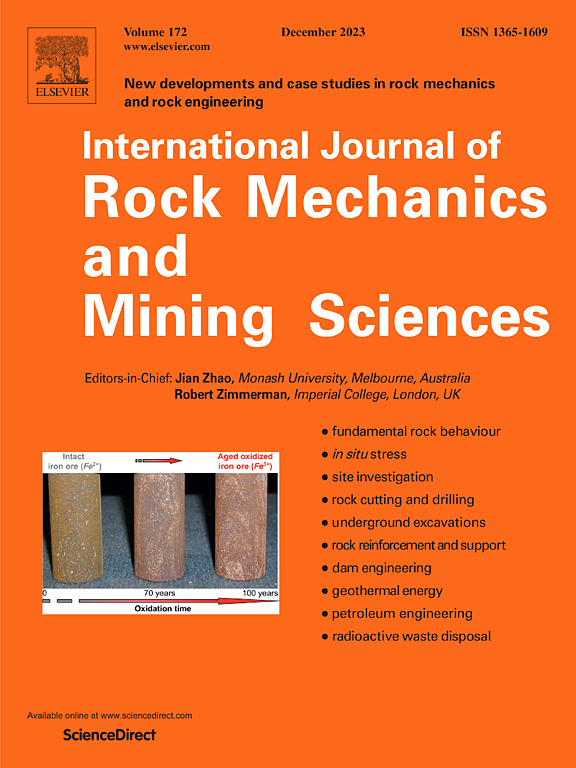冲击破碎高保真数值模型的多准则验证:迈向新一代冲击钻模拟
IF 7.5
1区 工程技术
Q1 ENGINEERING, GEOLOGICAL
International Journal of Rock Mechanics and Mining Sciences
Pub Date : 2025-04-20
DOI:10.1016/j.ijrmms.2025.106125
引用次数: 0
摘要
随着数值模拟技术在矿山、隧道、石油等工程领域的广泛应用,如何提高仿真工具的准确性以保证其可靠性已成为人们广泛讨论的问题。利用基础岩石力学实验对数值模型进行验证,在将这些模型应用于更复杂的试验时,往往会遇到问题,导致模拟结果失真。为了解决这一问题,本研究以冲击钻井的单次冲击试验为例,重点研究了钻头-岩石相互作用过程中的两个关键方面:钻头能量损失和破碎形态,包括岩石开裂程度的指标。选取与这两个方面相关的7个准则来验证FDEM模型的准确性。模拟结果在两种类型的硬沉积岩中得到验证:圣安妮石灰岩和隆恩砂岩。不同冲击能下的数值模拟结果与实验结果吻合较好。FDEM模拟结果准确再现了实验观察,捕获了实验CT扫描和高速视频记录中观察到的不同裂纹形态及其演变。模拟重现了实验中观察到的石灰岩中有中间裂缝而砂岩中没有中间裂缝。值得注意的是,模拟结果显示,侧裂纹的产生并不一定是由于中间裂纹的闭合引起的,因为中间裂纹并不总是像文献中假设的那样初始化。相反,FDEM模拟结果表明,侧裂纹的扩展主要是由岩石弹性恢复引起的撕裂引起的。本文章由计算机程序翻译,如有差异,请以英文原文为准。
Multi-criteria validation of hi-fidelity numerical model of impact breakage: towards next generation percussion drill simulation
With the extensive application of numerical simulations in engineering fields such as mining, tunnelling, and petroleum, enhancing the accuracy of simulation tools to ensure their reliability has become a widely discussed issue. Using basic rock mechanics experiments to validate numerical models often encounters problems when these models are applied to more complex tests, resulting in distorted simulation results. To address this issue, this study uses single impact tests indicative of percussive drilling as an example, focusing on two crucial aspects during the bit-rock interaction: bit energy loss and the breakage morphology, including metrics for the extent of rock cracking. Seven criteria related to these two aspects were selected to validate the accuracy of the FDEM model. The simulation results were validated against two types of hard sedimentary rocks: St Anne limestone and Rhune sandstone. The numerical simulation results at different impact energies agreed well with experimental results across these seven criteria. The FDEM simulation results accurately reproduced the experimental observations, capturing the different crack morphologies and their evolution as observed in experimental CT scans and high-speed video recordings. The presence of median cracks in limestone and absence in sandstone, as observed in experiments, was reproduced by the simulations. Notably, the simulation results reveal that the generation of side cracks is not necessarily caused by the closure of median cracks because median cracks do not always initiate, as postulated in the literature. Instead, FDEM simulation results indicate that the propagation of side cracks is primarily caused by the tearing induced by the elastic recovery of the rock.
求助全文
通过发布文献求助,成功后即可免费获取论文全文。
去求助
来源期刊
CiteScore
14.00
自引率
5.60%
发文量
196
审稿时长
18 weeks
期刊介绍:
The International Journal of Rock Mechanics and Mining Sciences focuses on original research, new developments, site measurements, and case studies within the fields of rock mechanics and rock engineering. Serving as an international platform, it showcases high-quality papers addressing rock mechanics and the application of its principles and techniques in mining and civil engineering projects situated on or within rock masses. These projects encompass a wide range, including slopes, open-pit mines, quarries, shafts, tunnels, caverns, underground mines, metro systems, dams, hydro-electric stations, geothermal energy, petroleum engineering, and radioactive waste disposal. The journal welcomes submissions on various topics, with particular interest in theoretical advancements, analytical and numerical methods, rock testing, site investigation, and case studies.

 求助内容:
求助内容: 应助结果提醒方式:
应助结果提醒方式:


